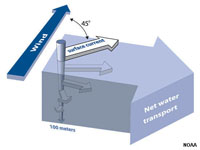9.5: Ekman Spiral and Ekman Transport
- Page ID
- 10284
Ekman Spiral and Ekman Transport
Early sailors traveling in regions where icebergs are common noticed that the icebergs moved in a different direction than the wind (causing alarm as the icebergs were cutting across the paths of ships moving down wind).

Figure 9.8. Sailors of ships noticed that icebergs move in a different direction than the wind.
Walfrid Ekman (1874-1954, a Swedish physicist) resolved the problem of why wind currents and water currents were not the same. The force of wind affect surface water molecules, which in turn, drag deeper layers of water molecules below them (drag is caused by friction between water molecules). The deeper below the surface, the slower the water moves compared to the water layer above it.
Surface movement ceases at a depth of about 100 meters (330 feet).
As noted above, both surface water and deeper water is deflected by the Coriolis effect.
—90° to the right in the Northern Hemisphere
—90° to the left in the Southern Hemisphere.
Depth is important: Each successively deeper layer of water moves more slowly to the right (or left), creating a spiral effect (called the Ekman Spiral). Because the deeper layers of water move more slowly than the shallower layers, they tend to twist around and flow opposite to the surface current. Net result is that net transport in surface currents is 90° from wind (Figure 9.9).
This twisting character of ocean surface waters is called the Ekman spiral. The impact of the Ekman Spiral is enhanced where geographic features create barriers to the movement of water. Ekman transport is the net motion of a fluid (seawater) as the result of a balance between the Coriolis effect and turbulent drag forces (within surface waters and geographic features (shoreline and seabed).



